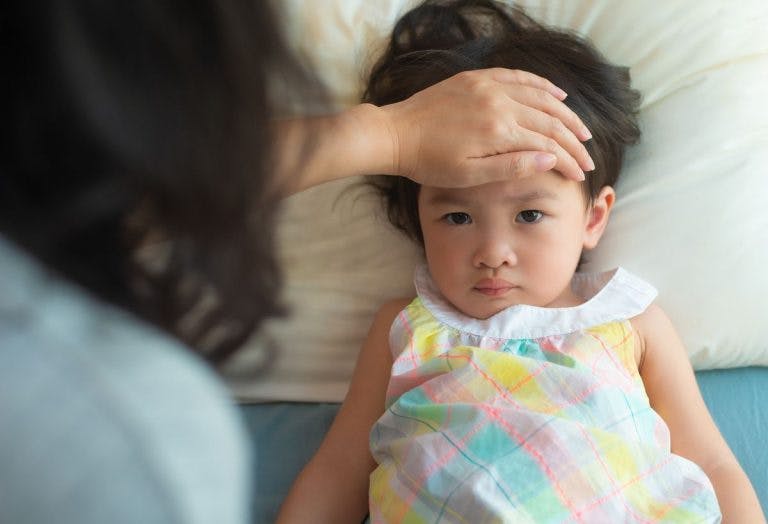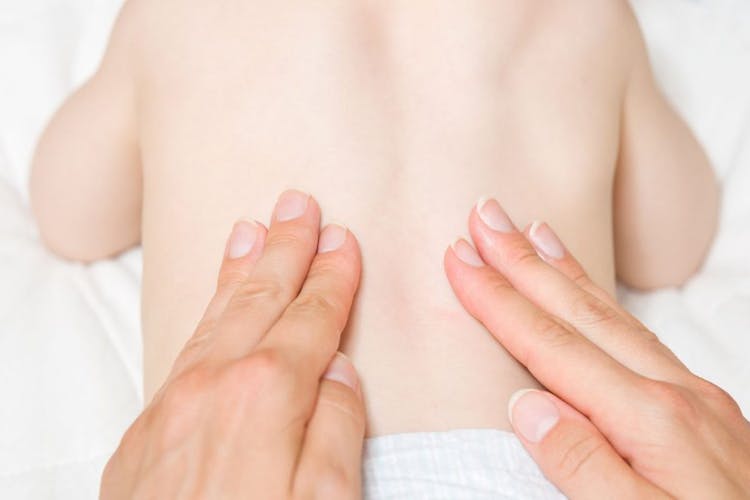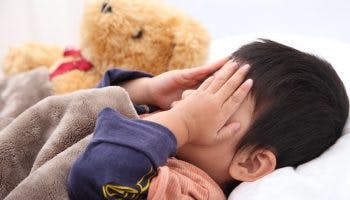Does Your Child Have Roseola Infantum? 5 Natural Ways to Treat It
Published | 5 min read
Roseola infantum causes high fever, cold symptoms, and sometimes a rash in young children. It's treatable using both Western medicine and TCM.

A high fever is a common concern among parents with infants or toddlers. Fortunately, if it’s roseola infantum, a common cause of high fever in young children, it will likely resolve soon.
Typically accompanied by cold-like symptoms and occasionally a rash, the fever usually resolves within three to seven days. Read on to learn more, including clinical and natural ways to help your little one through the illness.
Roseola Infantum: Causes and Symptoms

Roseola infantum (“rose rash of infants”) is also known as exanthema subitum (“sudden rash”) and sixth disease. The “sixth” refers to human herpes 6 virus that accounts for most roseola infantum cases.
- Fever higher than 39.5 degrees Celsius
- Cold symptoms such as a runny nose, cough, sore throat, upset stomach, and general discomfort
- Non-itchy red rashes that start on the trunk and spread to the limbs
- Febrile seizure
A high fever that appears suddenly is the most common feature of symptomatic cases. Meanwhile, the red rash that occurs soon after the fever subsides affects about 20% of cases. Some children may appear fine other than the high fever, while others may also present with cold-like symptoms. A febrile seizure due to the high fever is found in about 10 to 15% of cases but is rarely harmful.
Treatment for Roseola Infantum
Treatment for roseola infantum focuses primarily on symptom management. Fever reducers such as paracetamol or ibuprofen can help bring down a child’s high temperature. Soothing fluids and vapour rubs may help those with cold symptoms. If your child gets a rash, it is typically not itchy or painful and will go away independently.
There is currently no vaccine for roseola infantum. A previous infection appears to protect from future infections. Infected children are most contagious earlier during the infection. The virus is transmitted via saliva and other respiratory droplets through coughing, sneezing, and talking. Proper hygiene and home isolation are recommended to prevent transmission.
Treating Roseola Infantum with TCM

In Traditional Chinese Medicine (TCM), roseola infantum arises due to the invasion of the exogenous Wind-Heat pathogen, similar to the common cold. The TCM treatment regimen focuses on dispersal, replenishment, and revitalisation, shares TCM physician Lim Sock Ling.
1. Herbal medicine for Wind-Heat dispersal
At the onset of fever, TCM emphasises the dispersal of the Wind-Heat pathogen. A commonly used herbal formula is
2. Paediatric tuina to reduce fever
Paediatric tuina, a TCM healing massage modality for infants and children, complements herbal medicine to reduce fever. In a 2019 study published in the Journal of Acupuncture and Tuina Science, tuina improved fever reduction by 10% compared to TCM herbs alone.
“As the characteristic of roseola infantum is high fever, paediatric tuina can be administered to reduce body temperature. Using the inner surface of the index and middle fingers, stroke the area above the spine from the neck down to the buttocks. This helps clear Heat and promote bowel movement,” says Physician Lim.
3. Clearing Heat and replenishing fluid using cooling herbs
“After the rash outbreak and fever subsides, TCM would use herbs to clear Heat and replenish fluid. Some examples are chrysanthemum (ju hua, 菊花), bamboo leaves (dan zhu ye, 淡竹叶),
4. Strengthen immunity against recurrent respiratory infections
Yu Ping Feng powder (玉屏风散) invigorates qi (vital energy) for consolidating superficies and is commonly used to strengthen the immunity of those who are prone to the common flu. In an eight-week study of 351 children with recurrent respiratory tract infections, researchers found it to be as effective as pidotimod (an immunostimulant). However, Physician Lim cautions that those with Yin Deficiency should avoid this formula.
5. Nourishment for vitality
In TCM, prevention is the frontline defence against any pathogen. Having roseola infantum may protect against future infections due to your child’s immune response to the first infection. However, in TCM, immunity is also built through nourishment.
“According to TCM, if vital energy is strong, the body will resist pathogens. TCM views viruses and bacteria as pathogens. To prevent roseola infantum, one needs to strengthen their vital energy or immunity,” advises Physician Lim.
Make sure that your child eats a balanced and nutritious diet. “Prioritise fresh foods and vegetables from the five colours associated with the internal organs in TCM, Heart, Kidneys, Liver, Spleen, and Lungs. Avoid foods with chemical preservatives,” she reminds.
Encourage your child to be active while also getting adequate rest. They should get enough movement and exercise during playtime, go to bed before 11pm, and learn to manage stress and anger.
Roseola infantum will resolve on its own and responds well to symptom management. It is such a common viral infection that many parents don’t even realise their child has it. Still, take heed of these natural remedies and prevention tips to ensure a swift recovery and healthy, happy days ahead.
References
- Cleveland Clinic. 2022. Roseola. [online] Available at: <https://my.clevelandclinic.org/health/diseases/15785-roseola-infantumsixth-disease> [Accessed on 28 September 2022]
- The Royal Children’s Hospital Melbourne. 2020. Roseola infantum. [online] Available at: <https://www.rch.org.au/kidsinfo/fact_sheets/Roseola_infantum/> [Accessed on 28 September 2022]
- KidsHealth.org. 2019. Roseola. [online] Available at: <https://kidshealth.org/en/parents/roseola.html> [Accessed on 28 September 2022]
- Official Journal of the Academy of Family Physicians of Malaysia. 2016. Fever and rash in an 11-month-old girl. [online] Available at: <https://europepmc.org/article/pmc/pmc5405327 – free-full-text> [Accessed on 28 September 2022]
- StatPearls. 2022. Roseola Infantum. [online] Available at: <https://www.ncbi.nlm.nih.gov/books/NBK448190/> [Accessed on 28 September 2022]
- ScienceDirect.com. 2021. Exanthems and Drug Eruptions. [online] Available at: <https://www.sciencedirect.com/topics/medicine-and-dentistry/exanthema-subitum> [Accessed on 28 September 2022]
- Complementary Therapies in Clinical Practice. 2021. Efficacy and safety of yinqiao powder combined with western medicine in the treatment of pneumonia: A systematic review and meta-analysis. [online] Available at: <https://www.ncbi.nlm.nih.gov/pmc/articles/PMC7834461/> [Accessed on 28 September 2022]
- Journal of Acupuncture and Tuina Science. 2019. Efficacy observation on pediatric tuina plus Chinese medicine for exogenous fever in children. [online] Available at: <https://www.researchgate.net/publication/333974623_Efficacy_observation_on_pediatric_tuina_plus_Chinese_medicine_for_exogenous_fever_in_childrenxiaoertuinapeihezhongyaozhiliaoertongwaiganfareliaoxiaoguancha> [Accessed on 28 September 2022]
- Multi-Disciplinary Publishing Institute – Molecules. 2019. Phytochemical Composition and Antioxidant Activities of Two Different Color Chrysanthemum Flower Teas. [online] Available at: <https://www.ncbi.nlm.nih.gov/pmc/articles/PMC6359479/> [Accessed on 28 September 2022]
- Indian Journal of Nutrition. 2015. The Amazing Bamboo: A Review on its Medicinal and Pharmacological Potential. [online] Available at: <https://www.opensciencepublications.com/fulltextarticles/IJN-2395-2326-2-106.html – ref6> [Accessed on 28 September 2022]
- Pediatric Investigation. 2022. Safety and efficacy of Yupingfeng granules in children with recurrent respiratory tract infection: A randomized clinical trial. [online] Available at: <https://onlinelibrary.wiley.com/doi/10.1002/ped4.12326> [Accessed on 28 September 2022]
Share this article on






